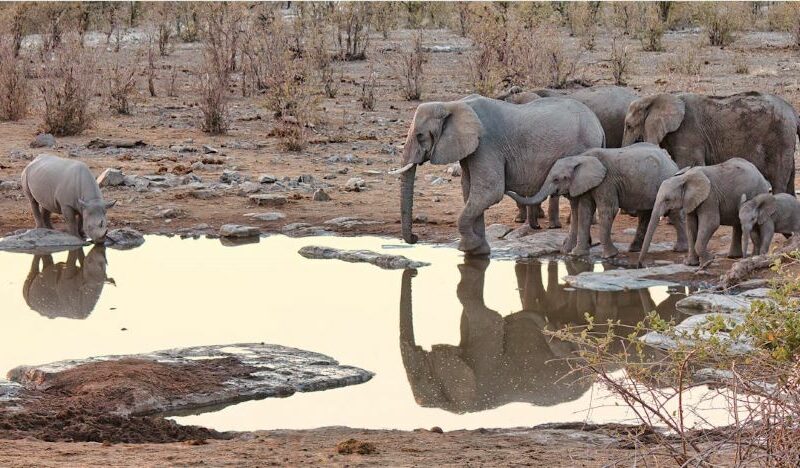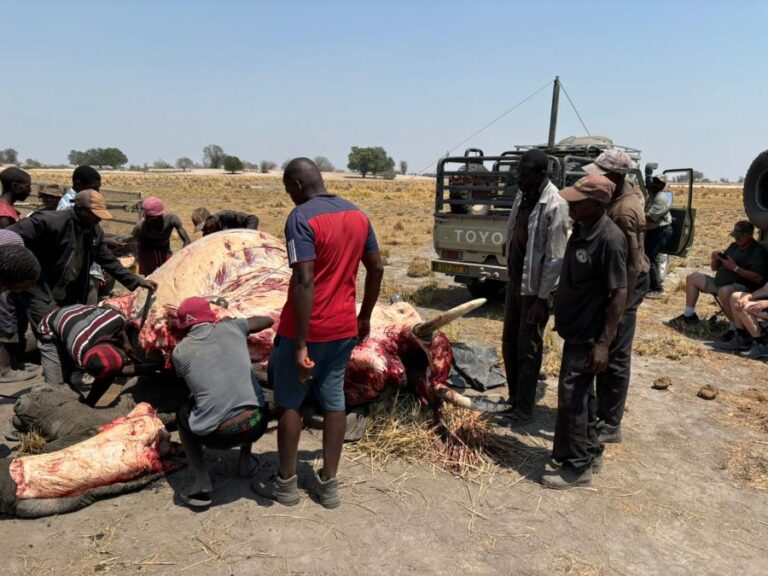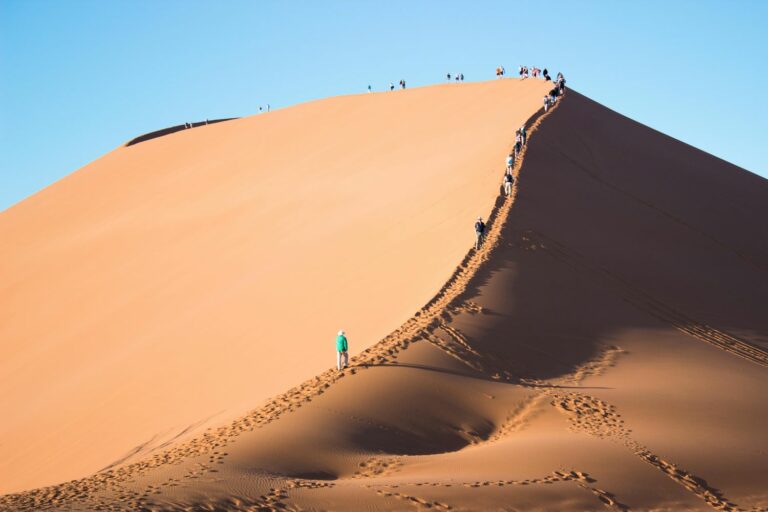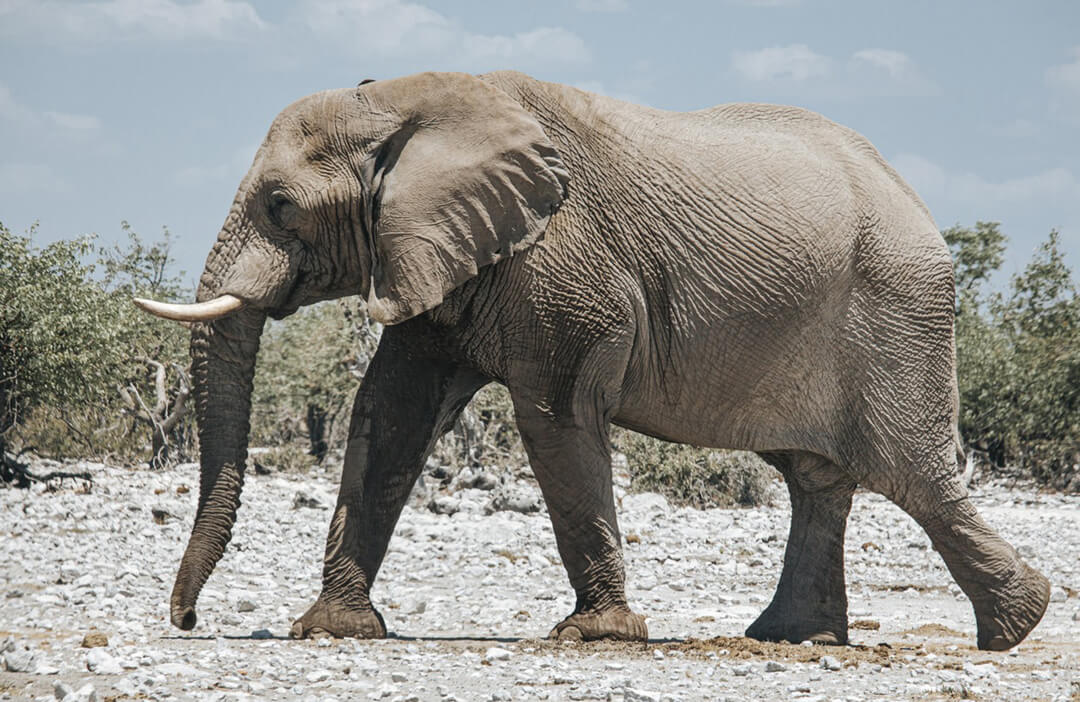For many hunters, engaging in a dangerous game hunting safari is almost a rite of passage, with one of Africa’s Big 5 always being a coveted trophy. Selecting your dangerous game hunting adversary, along with your destination, is crucial to ensuring you have the desired hunting experience. Discover more about what makes Namibia such a favored destination for dangerous game hunting and why elephant hunting in this premier location appeals to so many hunters.
[DYNAMIC-BLOGTABLEOFCONTENT]
Key Takeaways
- Namibia is the only destination worldwide where all members of Africa’s Big 5 can be hunted, and is also the only country where the cheetah can legally be hunted.
- Other dangerous game species include the hippo and crocodile.
- Namibia remains a largely undiscovered gem in terms of hunting opportunities available within this African country.
- The country is renowned for its exceptional elephant hunting safari experiences.
- The two main areas for elephant hunting in Namibia are Bushmanland and the Zambezi Region.
- Elephants are hunted using the walk-and-stalk method.
Namibia: The Land of Sand
- Often referred to as the “Land of Sand,” Namibia is largely an undiscovered gem just waiting to be explored. The country remains a valuable contender for those hunters seeking a destination ticking all the boxes: Seamless travel, value for money, safety, variety of species, tourist attractions, and exceptional hunting areas.
- It is seen as a safe, politically stable country to travel to within Africa and is easy to access from both Europe and within the continent itself, with daily flights arriving from various international destinations. Being so large, the destination also offers numerous domestic flights, which come in handy when road transfers across the vast terrain would simply take too long.
- For many first-time hunters, travel into “deepest, darkest Africa” can be quite daunting, and confirmation that your chosen destination is seen as safe, is rather reassuring. Namibia has a reputation as being one of the safest and most politically stable countries on the continent, with its game hunting industry well-regulated. Windhoek, Namibia’s capital city, is also renowned as one of Africa’s cleanest and safest cities.
- Namibia is home to a wide array of species, with some endemic species such as the Black-faced impala and the Damara Dik-Dik being sought-after trophies in this exquisite destination. African plains game hunts are exceptionally popular, with trophies including the striking Oryx, Greater Kudu, Blue and Black Wildebeest, Cape Eland, and Red Hartebeest, to name but a few.
- The area is renowned for its dangerous game, and the only country worldwide where every member of the Big 5 can be hunted. Added to this, the hippo and crocodile are also available to hunt, ensuring that each member of the Dangerous 7 can be harvested to challenge a hunter’s skills, perseverance, and courage. From elephant hunting in Bushmanland to targeting the mighty hippo in the Caprivi, Namibia remains a premier destination for dangerous game hunting safaris.
- Hunters will experience a variety of terrain when hunting in Namibia, ranging from thorny savanna and semi-desert plains to mountains and lush regions, such as the Zambezi.
- Outfitters in Namibia are extremely knowledgeable and proud to share the beauty that the country has to offer visitors. By providing hunters with positive, memorable hunting experiences and top-quality species during the hunt, they not only reinforce the message of Namibia as a top hunting destination but also reiterate how well-governed and regulated the hunting industry in the country is.

Why Go Elephant Hunting in Namibia?
- Elephant hunting in Namibia provides hunters with the ultimate challenge and the opportunity to hunt one of Africa’s Big 5 in a diverse and testing environment.
- The country is renowned for producing large elephant bull trophies with great tusks!
- Namibia prides itself on its strict hunting regulations and its commitment to ethical and sustainable hunting practices. Did you know that only 1% of the elephant population is hunted annually in Namibia?
- By participating in a Namibian elephant hunt, you are assisting in and supporting wildlife conservation in the region. A portion of the hunting fee is used for anti-poaching patrols, the rehabilitation of wildlife habitats, as well as numerous other conservation initiatives.
- When you enjoy an elephant hunt, you are supporting local communities. This is done through the employment of locals as trackers, skinners, cleaners, and other staff for the hunting safari, while the distribution of meat from the hunts provides a much-needed food source to the rural communities. For many, this will be the only source of protein they have – until the next hunt.
- Hunting tourism forms a significant portion of the country’s GDP.
- Namibia provides assorted landscapes from deserts and floodplains to mountains and lush vegetation, for hunters to enjoy a range of landscapes during their African hunt.
- Problem elephants can often be targeted and lessen the challenge of human-wildlife conflict.

Elephant Hunting Regions
Elephant hunting in Namibia is generally done within two regions:
- The Zambezi Region, formerly known as the Caprivi Strip
- Bushmanland
While there are other regions where elephant hunting in Namibia is undertaken, such as Erongo, Kaokaveld, and Kunene, the Zambezi and Bushmanland regions are the main areas.
The Zambezi Region is home to Namibia’s highest rainfall area, with summer rains transforming the region into a lush, green oasis with grasses that elephants love sampling. The Zambezi Region is situated in the Northeast of the country, sharing borders with Angola, Botswana, and Zambia. Botswana is known to have the highest number of free-range elephants on the continent, and many elephant bulls find their way into Namibia’s territories, ensuring that there are always huntable elephant bulls in the region.
Free-range elephant hunting in Namibia’s Bushmanland challenges hunters in one of the country’s largest conservancies. The area sports Kalahari sands, flat landscapes with pans, as well as seasonal waterholes that are often visited by an array of species, including elephants. Vegetation includes Acacia trees and woodlands, as well as grassy plains.
Elephant Hunting Methods & Calibers
Dangerous game hunting in Namibia legally requires that a minimum of a .375 caliber rifle needs to be used on a hunt, and no bow or cross bow hunting of dangerous game is allowed.
Elephant hunting in Namibia is usually undertaken using the walk-and-stalk method. This can prove very challenging, as it is very difficult to approach these giant mammals undetected.
How does Elephant Hunting Support Local Communities?
Elephant hunting in Namibia supports local communities in numerous ways. Firstly, it allows the hunter the thrill of dangerous game hunting in diverse landscapes and terrain and offers exceptional trophies. Hunters depart after an elephant hunt with a positive and memorable experience of their time in Namibia and often return, thereby ensuring further revenue for the country and locals.
Elephant hunting contributes to and supports local communities through the employment of local people as trackers, skinners, and support staff. Employment in rural Africa is hard to come by, and the employment of people by local hunting outfitters and within the hunting industry is a major source of income for these poor communities.
Fees generated from elephant hunting safaris, and other hunts, help assist with community development, such as local schools, clinics, and so forth. These fees also contribute towards anti-poaching efforts, as well as wildlife conservation projects and initiatives.
Hunting revenue provides incentives to local communities to protect wildlife and their habitats, as they benefit from the sustainable hunting practices.
Hunters can be called in to target an elephant that is causing a challenge in local communities and hunt it. For example, it may be destroying local crops or property and by harvesting this specific elephant, human-wildlife conflict can be avoided.
Elephant hunts supply local communities with much-needed protein when the animal is harvested and assists in feeding poor communities.

Tips when Elephant Hunting in Namibia
- Ensure that you have researched the animal’s behavior and habitat, the more that you know about the elephant, the better. This member of Africa’s Big 5 can turn aggressive very quickly, be prepared.
- Research spot placement options for elephants to ensure a quick, clean, and ethical death for the animal.
- Work on your fitness. Elephant hunts can be very taxing and demanding on the body and require you to walk many miles each day.
- Be patient. Only take the shot when you know it is accurate and immediately be ready with backup shots in quick succession.
- Listen to your PH explicitly. They are the experts. It’s just as simple as that.
- Elephants have a good sense of smell, so keep an eye on the wind direction during the hunt.
- Elephants are tough. While a .375 is the legal requirement when dangerous game hunting in Namibia, choose the largest rifle that you are comfortable shooting with.
- Elephant hunting takes patience, perseverance, and focus. Prepare yourself mentally for this hunting challenge.
Lastly, although not specifically aimed at elephant hunts, don’t forget to stay hydrated and apply sunscreen. The African sun can be deceptively harsh, even on cloudy days.
Pre- or Post-Hunting Activities: Namibia’s Diverse Tourism Offering
It’s true what they say about something ticking all the boxes, and Namibia certainly ticks the boxes with its wide range of tourist activities appealing to young and old, families, singles, or couples, looking to explore this diverse destination. Think action, think adventure, think relaxation, and everything in between:
- Zambezi Region: The Zambezi region, formerly known as the Caprivi Strip, is situated in northeast Namibia and is renowned for its lush vegetation and greenery. It is the perfect habitat for numerous species of mammals, reptiles, and many varieties of birdlife.
- Swakopmund: From camel rides and desert tours to quad biking in the world’s oldest desert, Swakopmund is the playground of adventure-seeking tourists.
- Sossusvlei: Sossusvlei is home to the world’s oldest desert, you have the chance to climb some of the world’s highest dunes, including Big Daddy.
- Fish River Canyon: Visit the largest canyon in Africa, reaching depths of 1,950 feet! With its breathtaking views, this canyon remains one of Namibia’s most popular tourist attractions.
- Windhoek: Windhoek is Namibia’s capital city and offers tourists a variety of heritage and cultural tours. Be sure to enjoy some traditional cuisine in a variety of restaurants in the city.
- Etosha: Etosha remains a prime destination, with its wide-open landscapes and array of abundant wildlife allowing for exceptional game viewing. Enjoy a game drive and learn more about the local fauna and flora, it’s fascinating!
- Walvis Bay: The cold Atlantic Ocean provides the perfect backdrop for an unforgettable boat tour, while friendly seals often hop on and off the boats, making perfect tour guides!

Frequently Asked Questions
Is elephant hunting in Namibia legal?
Yes, elephant hunting in Namibia is legal. One of Africa’s Big 5 animals, the elephant is often hunted for its tusks and meat.
Do you need a CITES permit to hunt elephants?
Yes, a CITES permit is required to hunt elephants.
What methods are used when elephant hunting in Namibia?
The elephant hunt will be undertaken on a walk-and-stalk basis, which comes with its own challenges of closing in on this wary mammal undetected.
How many elephants are there in Etosha?
The Etosha National Park is said to have more than 2,500 elephants.
Conclusion
Elephant hunting in Namibia remains a bucket list activity for many: The opportunity to target the world’s heaviest land animal on its home turf and walk away with a great trophy…priceless!
Check out the latest elephant hunts available in Namibia.
